SA Standard Service Dagger by Lauterjung (Tiger; maker marked)
CATEGORY: Version
SKU: 51.GOR.04.03.008.002
Estimated market value:
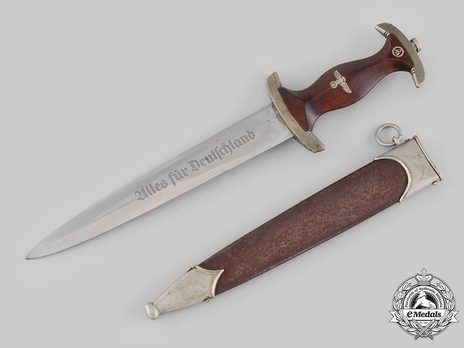
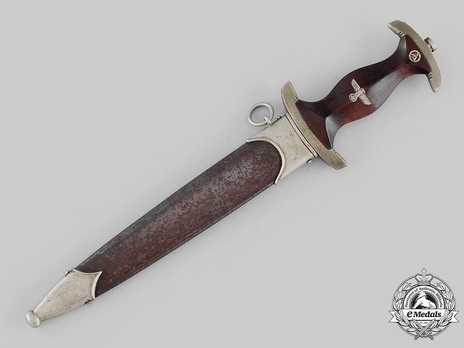
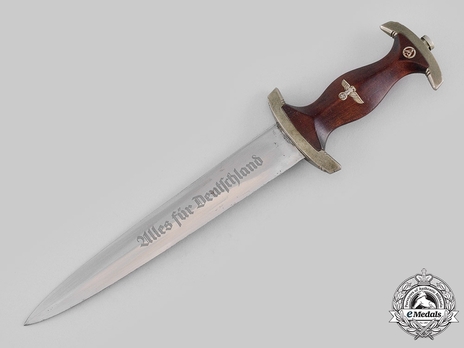
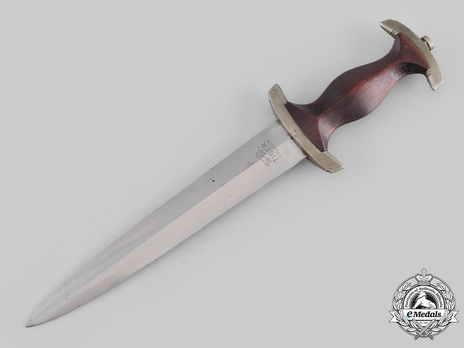
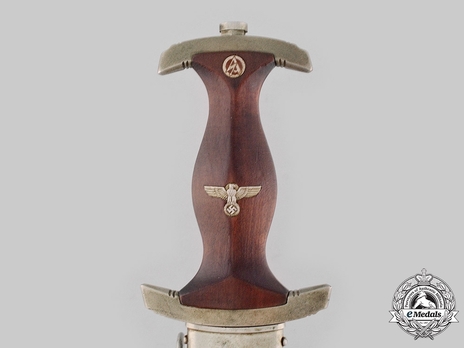
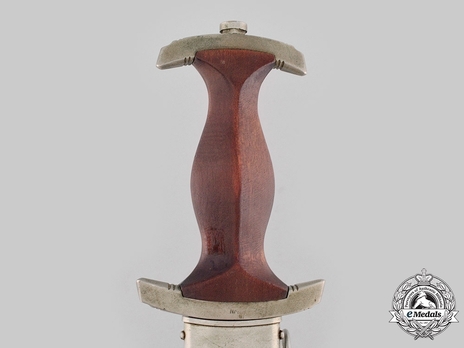
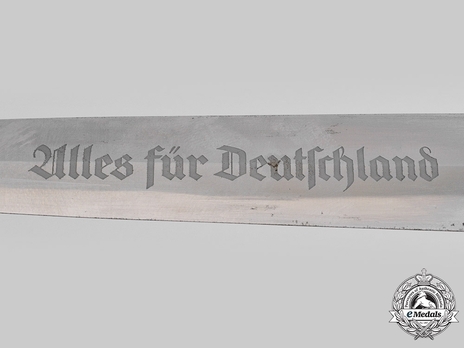
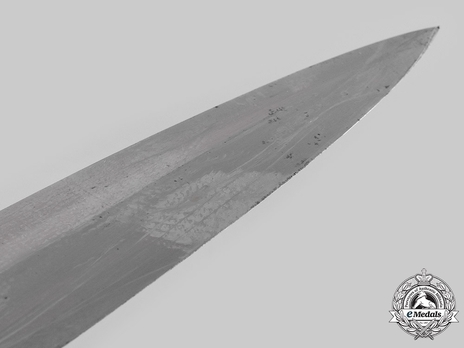
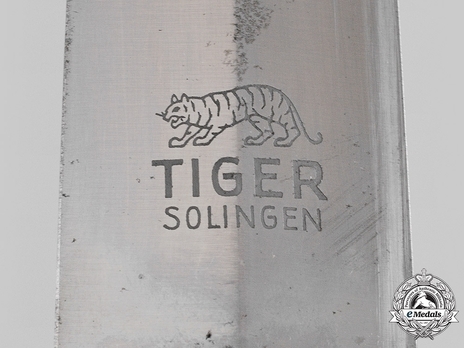
Estimated market value:
A very well-preserved Model 1933 Sturmabteilung (SA) dagger, measuring 375 mm in length when inserted into the scabbard. The dagger features a 225 mm-long nickel-plated magnetic metal blade, with a sharpened tip and semi-sharpened edges, the obverse of which features an acid-etched inscription of “ALLES FÜR DEUTSCHLAND” (“EVERYTHING FOR GERMANY”). The reverse ricasso bears a maker’s mark of “TIGER, SOLINGEN” for the firm of Lauterjung & Co., along with the company’s tiger logo. The blade sits flush with the nickel-plated zink upper crossguard, itself bearing eight notches, with four each distributed at the top and bottom. The reverse is inscribed with “NRH” for SA Group Niederrhein. The handle is constructed of wood with a well-defined grip, with the obverse inset with a metallic NSDAP-style German national eagle clutching a wreathed mobile swastika, measuring 25 mm (w) x 14 mm (h). The handle is also inset with a metallic SA logo measuring 9 mm in diameter. The dagger completes with a nickel-plated zink lower crossguard, similarly marked with eight notches, and a magnetic metal pommel nut. It is accompanied by a period scabbard, constructed of brown-painted magnetic metal. The throat retains a functional spring catch, securely holding the dagger in place during storage, and is held together by dual rivets. It also bears a loop for the accommodation of a dagger hanger. The scabbard completes with a nickel-plated tip held in place by dual rivets. Minor running marks are evident to the blade, and there is some oxidation and loss of paint evident to the scabbard and zink elements of the dagger. It is in an overall better than very fine condition.
The SA (Sturmabteilung, storm detachment) was established in 1921 as a paramilitary protection squad of the NSDAP. The members of the SA were tasked with protecting party leaders at political rallies and meetings from the paramilitary forces of the opposing political factions. The SA was first utilised on November 4, 1921 at a meeting held in Munich’s "Hofbräuhaus" beer hall. The organisation was banned after the failed putsch in 1923 and was reactivated in February 1925.
The SA Standard Service Dagger was introduced in 1933. It was the first edged weapon sidearm that was approved by the NSDAP. The daggers were distributed by authorised retail stores and all ranks were allowed to carry the weapon. This dagger was the most widely produced one in the Third Reich, with over 100 manufacturers and 200 factories involved in its production.
The standardisation and inspection of the daggers did not begin until late 1933, and as a result, numerous design variations involving colour, size, and materials can be encountered when examining early daggers. In October of 1934, the RZM was instituted to regulate items produced for the NSDAP. The RZM made many subtle changes to the dagger design and all items the organisation approved were stamped with an RZM logo.
The dagger blade was manufactured out of nickel-plated steel and features the motto “Alles für Deutschland” (everything for Germany) etched on the obverse. Prior to standardisation, the motto was etched in a variety of patterns. Prior to the establishment of the RZM, the reverse of the dagger was stamped with the manufacturer’s logo. After 1934, the reverse of the blade was stamped with an RZM logo and the manufacturer’s trademark. In 1936, manufacturing trademarks were replaced with RZM-issued manufacturer's codes. Privately-purchased daggers continued to be marked with the maker’s trademark.
Some daggers can be found personalised in one or more of several ways, for example with the owner's name stamped onto the fittings or etched onto the blade.
Early versions of the scabbard were either produced out of a copper-based material or a steel-based sheet metal. In both cases, the scabbard was then finished with brown paint or a reddish-brown oxide (after 1936 oxidised scabbards were no longer produced). It was eventually determined that the copper-based material was too soft and the scabbards were only to be produced out of the steel-based sheet metal. The hilt and scabbard fittings were originally manufactured out of polished nickel-silver, but this was later changed to nickel-plated or chrome-plated zinc die castings.
The dagger grip was produced out wood and stained brown. A variety of different wood, including pear, apple, and walnut were used. The upper section of the grip features an inlaid SA symbol, and from 1933 to 1934, a national eagle emblem with an elongated body and pointed wings was inlaid below. In 1934, a solid nickel or silver-plated eagle emblem with rounded wings replaced the old pattern. As of 1936, many manufacturers began to produced the eagle emblem out of stamped aluminium. At the same time, manufacturer’s began to produce the upper and lower crossguard out of nickel-plated or chrome-plated zinc in order to reduce the cost of production.
The dagger was suspended from the uniform with a brown leather strap that had a nickel-plated clip at one end, and a nickel-plated buckle at the other end. The strap attaches to a carrying ring on the top section of the scabbard.
After a dagger was produced, it was shipped to distribution centres where SA personnel could purchase them. Some daggers feature district markings on the handguard which indicate where the dagger was purchased. Each district was allotted a two to three letter code, such as WF for Westfalen.
For a short time, a variation of the dagger was produced for members of the Marine-SA (navy SA) that featured a black grip and a black anodized scabbard. This variation is extremely rare. Marine-SA members soon started wearing regular service daggers with gilt or copper-plated fittings instead.

Comments
Sign in to comment and reply.


Scroll Top